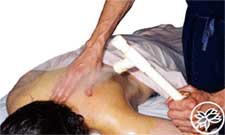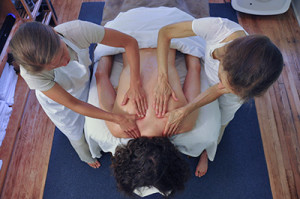Musculoskeletal Pain and Inflammation
One of the most common ailments people suffer from is musculoskeletal pain. Aside from specific or repetitive use injuries, pain can also may be due to the increased sedentary life of our modern world, which often entails spending extended periods of time sitting in a car or a desk at work. One of the most important things we can do to counterbalance how much we sit is to get regular daily exercise, and as often as possible take walks out in “the elements” of nature to unwind and replenish our body and mind. Traditional Ayurvedic therapies can help immensely to relieve pain in the joints, muscles and tendons, while removing toxins and nourishing the bodily tissues.
Pain Relief with Nadi Swedana
Nadi swedana is a traditional localized steam treatment that is used as an adjunct therapy to the cleansing measures known as panchakarma (deep cleansing and rejuvenation), or administered as a day treatment as often as needed. A session consists in receiving a jet of herbally infused steam to specific areas of the body, while medicated oils are vigorously massaged on the site at the same time. This drives the properties of the herbal oils deep into the tissues, stimulating circulation and  burning away ama (toxins). The steam is infused with blood moving herbs like eucalyptus, sage, cinnamon, camphor, ginger, or calamus to remove stagnation, dispel waste products and counteract the cold qualities of vata in the muscles and joints.
burning away ama (toxins). The steam is infused with blood moving herbs like eucalyptus, sage, cinnamon, camphor, ginger, or calamus to remove stagnation, dispel waste products and counteract the cold qualities of vata in the muscles and joints.
It mainly targets excess vata and kapha conditions and is used to address a wide variety of musculoskeletal disorders. Even inflammatory conditions can be calmed by settling the wind-like characteristic of vata dosha. Typically, the focus of the procedure is on the troublesome areas, such as low back, knees, as well as the neck and shoulders, but can also be performed on larger areas of the body as a general vata management therapy.
Relief from Injury
Nadi Swedana is also a useful for treating sports related and other injuries and is often more appropriate than ice alone after the acute first aid period( within 24-48 hours after an injury. If ice needs to be used beyond this period, then contrast therapy is great. Here, alternate a cold compress with heat serval times and finally ending with heat. If the trauma is severe and there is a tremendous amount of pain and inflammation, such as post orthopedic surgery or a bad sprain, ice should be used for a longer periods to drive down inflammation. Here, heat alone might make the pain worse. Your body will often tell you when something helps or aggravates, so some experimentation may be needed.
When to Use Ice
Ice certainly has it’s place in first aid and is as respected as much as heat when it comes to applying the proper treatment at the proper time. Yet in Ayurveda, ice is not typically used to treat chronic muscles and joint conditions. Cold quality constricts the muscles and blood vessels, which can contribute to further stiffness as well as blood and fluid stagnation. Excessive application of ice can causes the memory of the trauma to “freeze” into the tissues, making it harder to remove the memory of the trauma. A sprain or strain that is only iced after the initially treatment phase can become even prone to re-injury. Here, Nadi Swedana is very helpful, as is contrast hot/cold therapy as mentioned previously.
Ayurveda has created numerous circulatory compounds, liniments, muscle plasters and oils for first aid as well as more long-term treatment of injuries to the joints and muscles. Some of the most commonly used are Maha Narayan oil, nirgundi oil, and turmeric-sea salt poultices.
A Great Addition to Massage Therapy
Nadi swedana can often be more effective than massage alone when dealing with a serious condition and can often provide almost instantaneous relief from chronic pain. It is perfect during the rehabilitation stages of injury and/or orthopedic surgery, once any wounds or incisions have completely healed.
This treatment is used in cases of chronic neck, back and shoulder pain, stiffness, cramps, atrophy, paralysis, bursitis, sciatica, sprains, strains, arthritis, rheumatism, and misalignment of the spine.
It can also be combined with other Ayurvedic therapies such as Abhyanga (Ayurvedic Massage) or Rasayana Day Spa packages. If you are in pain, you have to experience it to believe it!
